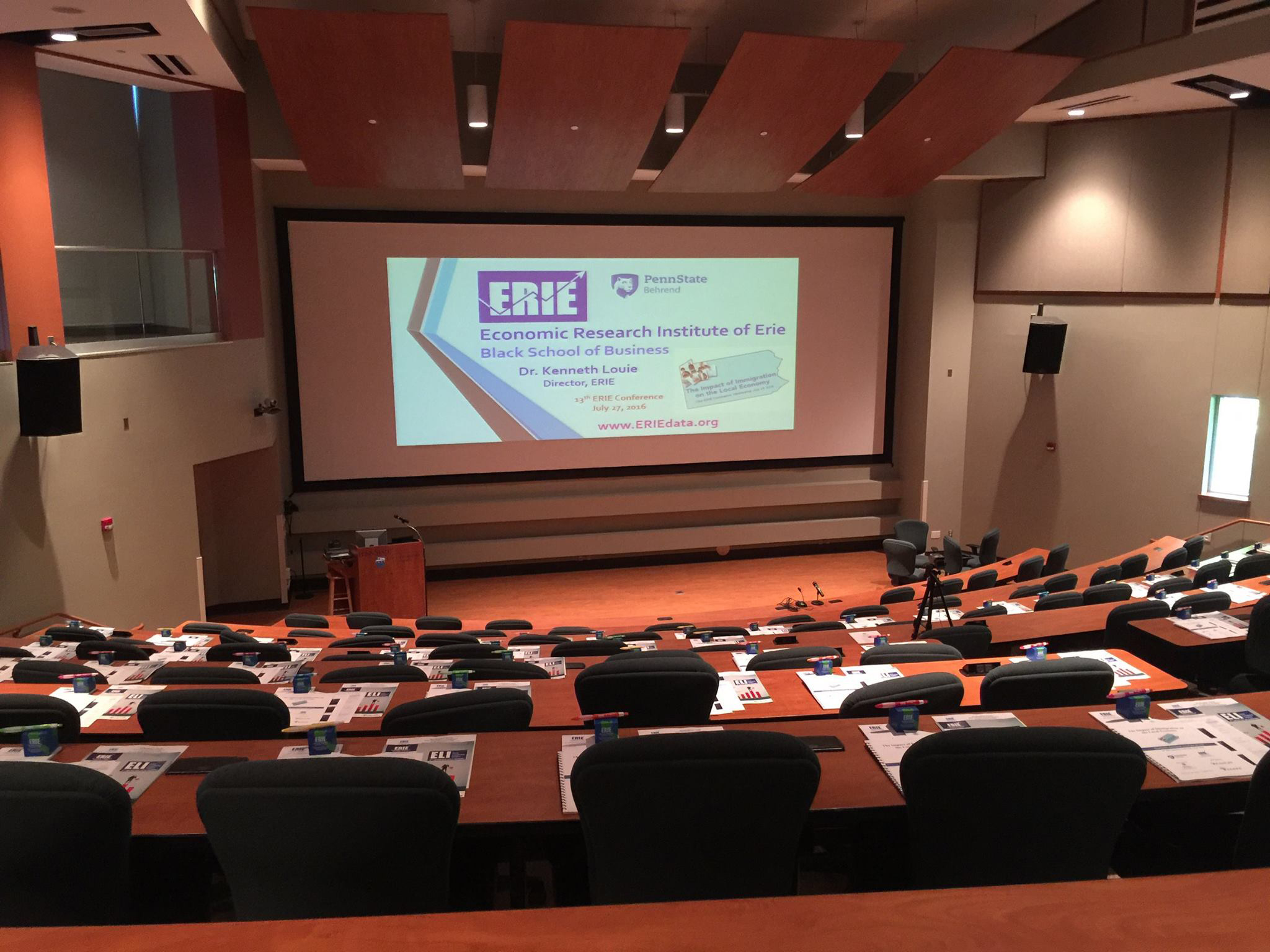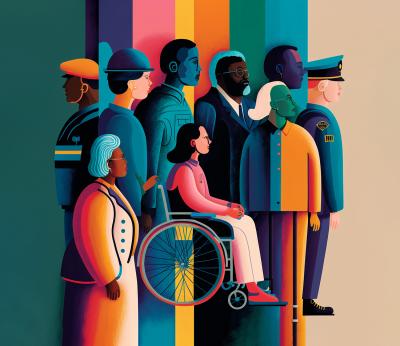The State of Erie's Economy 2024
The impact if Erie closed its race and gender wage gaps
If the read on the state of the economy in Erie in 2023 following the annual conference hosted by the Economic Research Institute of Erie (ERIE) was "stable, but slightly sluggish," 2024's take might be summed up as "still stable" overall, and "slightly less sluggish" when it comes to the pace of recovery and growth.
As is customary at the yearly gathering, economist Ken Louie, director of ERIE at Penn State Behrend, reviewed the available data, offering attendees insights into where Erie stands with recent trends – this year on July 25. Louie also explored future prospects in light of this year's conference theme, Equity and Inclusion: Potential Economic Gains, introducing a thought experiment to ponder and project where we could grow from here if earning and wage gaps were closed.
In sum, Erie's economy is continuing to grow, albeit at a still-slow pace. Erie is still working to catch up to its 2019 economy in terms of total nonfarm jobs, while that of the U.S. economy, on the whole, has continued to exceed pre-COVID positions.
The reasons for the lagged response are, of course, complex. But asking a question seemingly simple but truly profound in its implications shines light on potentially brighter, more prosperous days ahead: What if we closed the gender, ethnicity, and race income earning gap? How much might that impact Erie's economy and expedite its economic growth?
If even just a rough estimate, Louie has that number. And it's impressive.
On the trends
In 2023, Erie had recovered 97 percent of its total nonfarm employment before the globally devastating impact of the COVID-19 pandemic that began in 2020. At the same time, however, the U.S. economy had not just returned to pre-pandemic economic measures; it had grown 3 percent beyond 2019 numbers by June 2023.
A year later, as Louie noted at the conference, Erie's economy has made up ground. But it continued to lag behind its full 2019 muster by roughly 2 percent, while the U.S. economy continues its growth. One indicator in 2024 where Erie's numbers bested the national average: the unemployment rate. As of May 2024, the latest data reported at the conference, Erie's unemployment rate had dropped roughly 12 percent to 3.5 percent from its April 2020 high. The national rate in May stood slightly higher at 4 percent; but, still, a marked decline from its nearly 17 percent high just over four years ago.
Another positive sign for Erie: ERIE's Erie Leading Index (ELI), a tool to measure and compare the local economy to the national, projects a recession is not lurking ahead in Erie's immediate future. This speaks to the continued stable nature of the Erie economy.
Conditions have, as they tend to do, changed since the July conference.
Inflation continues to cool further, and the Federal Reserve lowered interest rates by half a percent, or 50 basis points at its Sept. 2024 meeting – the first cut since the early days of the pandemic. And new data, like that of the Bureau of Labor and Statistics, has been released since the conference.
"We're just about a little more than a thousand jobs below pre-pandemic numbers," Louie told me when we spoke a little over a month after the conference. "So, it's even better than what was true at the conference."
That amounts to being at roughly 99 percent of Erie's pre-pandemic standards.
An optimistic note, according to Louie, is that the manufacturing sector in Erie "seems to be undergoing a resurgence." From July 2023 to July 2024, some 1,800 manufacturing jobs were added to the Erie economy.
Another positive note, Louie told me, is the continued strengthening of the education and health care sectors, which added over a thousand jobs. Manufacturing and education/health care are two of Erie's biggest economic sectors, along with finance, insurance, real estate, rental, and leasing. According to the U.S. Bureau of Economic Analysis, finance/insurance, the largest piece of the pie, accounts for nearly 20 percent, or $2.2 billion, of Erie's economy. Health care, education, and social assistance make up just over 17 percent, or $1.9 billion, while manufacturing stands at $1.8 billion, or just over 16 percent, of the economy. Together, that's over half, with all other sectors totaling just shy of 47 percent, or $5.3 billion.
Those are actual, real numbers when it comes to Erie's economy. An imagined one with significant potential economic impact: $765 million. That is the amount, in dollars, Erie would stand to add to its GDP if earning gaps along gender, ethnic, and racial lines were to be closed.

The theme of this year's ERIE conference at Penn State Behrend was "The Potential Economic Gains from Greater Equity and Inclusion," and Ken Louie, director of ERIE, put that potential into real numbers. (Photo: Penn State Behrend)
On the future prospects
Turning to the 2024 ERIE Conference theme, Louie explored "The Potential Economic Gains from Greater Equity and Inclusion" to game-out an answer to the question: What are estimated potential gains to the Erie economy from reducing racial, ethnic, and gender earnings gaps?
The answer: $765 million in labor income, or 6.8 percent of Erie real GDP in 2022, annually.
As Louie recounted to me, the path to asking the question, and arriving at an answer, happened in a serendipitous way.
The morning of the day he was scheduled to deliver a presentation at the Jefferson Educational Society, the Erie-based nonpartisan think tank, he'd come across an article that piqued his interest. It was on measuring the economic impact of closing racial, gender, and ethnicity income earning gaps. Because his presentation later that evening was not about that, he'd filed it away with the intention to return to it in the near future.
But at that 2023 presentation, an attendee, Art Leopold, asked a question about closing such earnings gaps. "I said, 'Oh, I just happened to read an article about it this morning!,'" Louie told me. So, he started talking about it with those in the audience. "It was like pulling a thread."
Leopold is a member of the Erie Racial Justice Policy Initiative, a collaborative effort led by a group of residents and advocacy organizations working to address public policy reform to tackle racial disparities and advance opportunities. Louie told me Leopold invited him to meet with the group for further discussion, which he did. And then he got to work.
Louie found national data answering the "what if…" question.
"Our main results show how closing gaps in the labor market variables by race and ethnicity, moving all groups to at least the levels of the white population, would boost the overall level of GDP in the nation," wrote Shelby R. Buckman, Laura Y. Choi, Mary C. Daly, and Lily M. Seitelman, in "The Economic Gains from Equity," published by the Brookings Institution in 2021.
In 2019, such adjustments would have added $1.28 trillion in total labor compensation to the U.S. economy. From 1990 through 2019, it would have added over $25.6 trillion.
From what Louie could find, no one had conducted the thought experiment at the local level. So, he did. And he revealed the findings at the 2024 ERIE Conference.
According to his calculations, based on U.S. Census Bureau, American Community Survey one-year estimates for 2022, if those whose earnings are less than white males are raised to the level that white males earn, it yields an increase of $765 million in labor income – or 6.8 percent of Erie's real GDP.
"If you had removed those earnings gaps, then in 2022, we could have theoretically generated over $750 million more of labor income," Louie explained to me. "So, the idea is that if those same conditions in the year 2022 continue to prevail, every year, conceivably, we could generate that."
The numbers and economic conditions do, of course, change from month to month and year to year, but as Louie put it to me in the broadest of terms, "it's hundreds of millions of dollars." Both at the conference and when we spoke later, Louie noted the importance of recognizing that these are very preliminary estimates. And Louie acknowledges, "more work has to be done."
Nevertheless, when he looks at these numbers, "they are consistent with the bigger, more prominent studies that have looked at the state and the national economies in terms of orders of magnitude. This gives me a bit more confidence," he told me.
"Erie is often said to be 'a microcosm of the nation', so that if those prominent scholars have found this for the nation and the commonwealth, then it's not surprising to think that we would find comparable results for Erie. That gives me more confidence in the results."
Too, as an economist, he's collecting and studying the data. These estimates do not suggest how, say, Erie, or any other metro region, may go about closing these earning gaps. And, even if or when the question of how to reduce such gaps is figured out, "it will require much time and dedicated effort," Louie said.
That, of course, is the hard work to be done.
"It's easier to find and estimate the size of the gap," Louie said. "But now, what do we do?" That is why it was important to Louie in determining the theme of 2024's ERIE Conference to be "Equity and Inclusion: Potential Economic Gains," and to line up speakers whose organizations are working to address such disparities – like the Erie Racial Justice Policy Initiative and others.
The pathways to a more equitable economy
Now that the earning gaps have been quantified, even if through what he humbly calls a "very, very simple thought experiment," Louie sees two major paths lying ahead. One, the academic, scholarly path, which involves more data mining and more analysis for a finer-tuning of the details to better informed decision making. That is the nature of his work.
The second, of course, is now that the obvious – gaps exist along gender and racial lines – has been made obvious and been made public, and we know, even in broad strokes, the economic implications of doing nothing (the absence of more than a three-quarters of a billion dollars annually into the local economy), something should be done.
"If we accept the fact that this estimate is fairly reliable, that it is at least ballpark, we're losing a lot of money," Louie told me.
In addition to the work being done by various groups that presented at this year's conference to address public policy changes, institutional changes at the corporate levels, which some organizations already do, would be a step in the right direction.
Because if employers paid those earning less than their white male counterparts, whose group median annual earnings are, on average, $56,200, the state of Erie's economy would stand to be celebrated as something far greater, powerful, and inspiring than 'slightly than less sluggish'.
You can follow Ben Speggen, vice president of the JES, and a contributing editor at the Erie Reader, on Threads and Twitter/X @BenSpeggen, and connect with him on LinkedIn.




